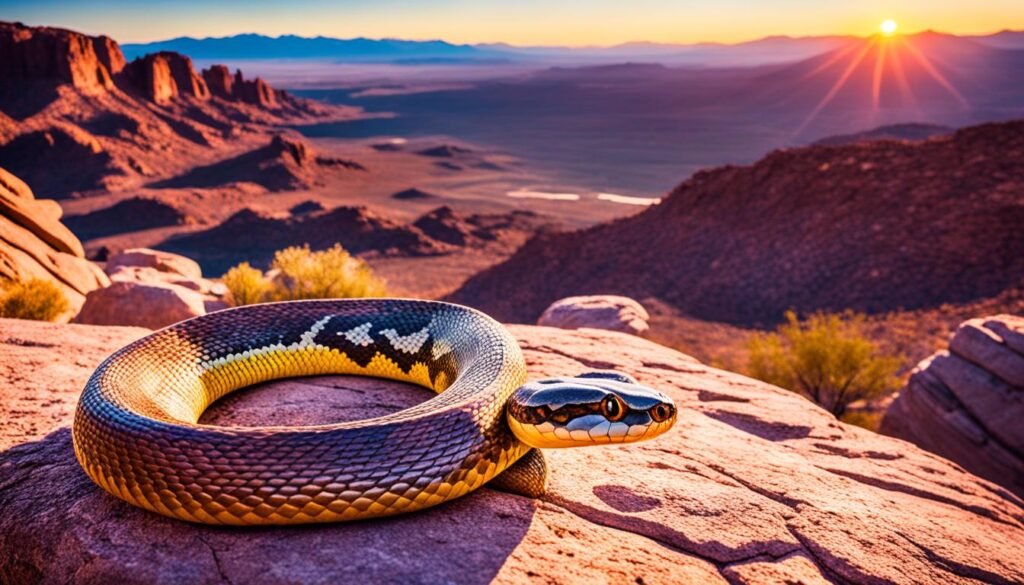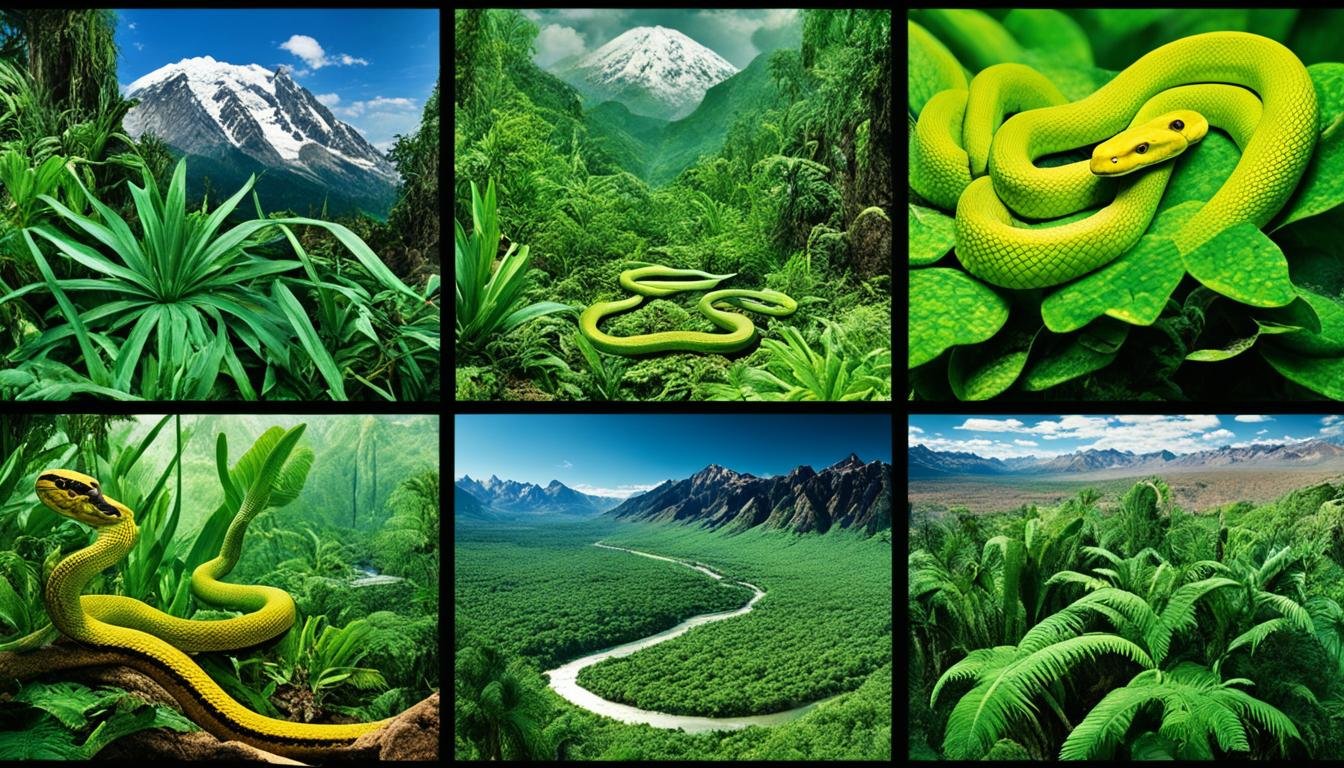Snakes can be found everywhere, from the hottest deserts to the wettest rainforests. They live in different places all around the world. This makes us wonder, “where do snakes live?” Their homes are as varied as they are, showing their incredible ability to adapt.
In places like forests, swamps, and deserts, snakes make their homes. They also live in both freshwater and saltwater. These creatures come out to hunt by day or at dusk. Their food includes rodents, insects, bird eggs, and small birds. Not all snakes are venomous, but some are, especially in regions like the United States.
Knowing where snakes live helps us appreciate their role in nature. It also teaches us how to live safely with them. Snakes can be found in cool underground burrows or in the branches of trees. They play a significant part in our planet’s diverse ecosystems.
Unraveling the Mystery of Snake Habitats
Snakes are found on almost every continent, showing how well they’ve adapted over time. They live in different climates, from dry deserts to wet rainforests. This amazing ability to survive in various environments helps us understand their survival skills and their role in nature.
Snakes have managed to live in different habitats worldwide. They survive in cold subarctic areas and hot equatorial places. Each habitat presents its own set of challenges. Snakes have developed unique ways to overcome these.
Snakes on Every Continent Except Antarctica
Every continent has its own types of snakes, except Antarctica. The cold there is too much for them. From North America’s deserts with rattlesnakes to African rainforests with green mambas, snakes are everywhere. This shows the variety and diversity of snakes around the world.
Adapting to Environments: How Snakes Thrive Globally
Snakes have adapted to their homes in amazing ways. They show a wide range of behaviors and features that help them live in different environments. From the Sahara desert to the Amazon rainforest, snakes have found ways to survive. They can handle various temperatures, hunt in unique ways, and have special behaviors for different places.
| Environment | Examples of Snake Adaptation | Notable Snake Species |
|---|---|---|
| Deserts | Nocturnal behaviors, water conservation, sand camouflaging | Sidewinder, Horned Viper |
| Forests | Arboreal locomotion, prey-specific venom, sensitive heat pits | Boa constrictors, Emerald Tree Boas |
| Aquatic | Amphibious abilities, salt excretion, paddle-shaped tails | Sea kraits, Water Cobras |
| Urban Areas | Opportunistic feeding, high reproductive rates, adaptive coloration | Common Garter Snake, Ratsnake |
This journey through the world of snakes shows more than survival of the fittest. It’s about who can adapt the best. Snakes’ habitats show their ability to face climate changes, isolation, and evolution. This makes them some of the most interesting and adaptable creatures on Earth.
Understanding the Diversity of Snake Habitats
Our planet is home to many snake species, each adapted to its surroundings. They can be found almost everywhere, from deserts to forests. They show how nature can vary. In the sea, sea snakes have special traits to live in water.
Scale-Covered Reptiles in Deserts and Forests
Desert snakes have learned to survive extreme heat and little water. They stay underground during the hot days and hunt when it cools down. Forest snakes use lush greenery to hide and hunt, moving through trees and plants.
Snakes have many ways to stay alive in different places. Some use venom to attack prey or protect themselves. Others, like constrictors, use their strength to catch food. It is fascinating to see how they adapt to their habitats.
Life in Water: Sea Snakes and Their Unique Adaptations
Sea snakes have adapted to live in the ocean. They have tails that help them swim and glands to remove salt. Their venom is strong but not a big threat to humans if left alone.
Let’s look at some facts about snakes, what they eat, and where they live:
| Attribute | Description | Species Examples |
|---|---|---|
| Venomous Snakes | Approximately 600 species, with only 200 posing significant risks to humans | Rattlesnakes, Cobra |
| Nonvenomous Snakes | Range from harmless garter snakes to formidable constrictors | Garter Snake, Python |
| Feeding Habits | Most consume their prey whole, capable of eating large meals thanks to their unique jaw structure | Boa Constrictor, Anaconda |
| Reproduction | Most lay eggs, but some, like sea snakes, give live birth | Olive Sea Snake |
| Endangered Species | About 100 species at risk, primarily due to habitat loss | Round Island Boa |
The diets of snakes show their important roles in the ecosystem. Some snake groups specialize in what they eat. This shows the deep bond snakes have with their homes, both now and in the past.
Where Do Snakes Live

Understanding where snakes live helps us know how they act and survive. The many kinds of snake habitats explain why snakes are found all over the world. This part talks about the different places snakes live in and shows how well they fit into their environments.
Snakes can handle hot places but can’t stay in extreme heat for long. They find cooler spots to survive. Most snakes we see are not venomous. In the U.S., venomous ones include rattlesnakes, copperheads, cottonmouths/water moccasins, and coral snakes.
- Western Diamondback Rattlesnakes, which vary in color from tan to nearly black, reign some forests in warm months.
- Rattlesnakes find relief in conservation, hibernating in dens when the weather cools.
- Warm and dry spots are their domain during the warmer seasons, whereas they seek shady shelter when temperatures peak.
- These vipers are known swimmers and use an iconic rattling sound as a defense against threats.
- Considering safety, it is prudent to depart from the haunting rattle of a rattlesnake upon detection.
Our world has over 3,000 snake species, with 600 venomous and about 200 able to seriously hurt humans. Habitat loss puts about a hundred species at risk of extinction. Sea snakes and kraits live in the Indian and Pacific oceans. Interestingly, five snake species have learned to glide from tree to tree.
| Snake Feature | Significance | Habitat Implication |
|---|---|---|
| Color Variation | Camouflage & Heat Absorption | Adaptation to Forest and Desert Environments |
| Rattlesnake’s Rattle | Predator Deterrent | Survival in Predator-Dense Regions |
| Hibernation | Energy Conservation | Endurance through Seasonal Extremes |
| Swimming Ability | Access to Aquatic Prey | Exploitation of Marine and Freshwater Habitats |
| ‘Flying’ Snakes | Aerial Mobility | Overshadowing Forest Ecosystems |
Snakes live almost everywhere, from dry deserts to the vast sea. They thrive in both the desert’s heat and the rainforest’s greenery. Their ability to adapt is a clear sign of evolution’s power. We must treat these snakes with respect and carefulness, securing their place in nature’s cycle.
Evolutionary Marvels: Snakes’ Adaptations
About 4,000 species of snakes vary in size and skill. These reptiles show how well evolution can work. They have changed to fit into many places well. They have evolved three times faster than lizards, their close relatives. Snakes are known for how they catch their food and the importance of their scales.
The Significance of Scales and Cold-Blooded Existence
Snake scales do more than look good. They help snakes move, protect them, and keep them from drying out. Since snakes are cold-blooded, they use the sun or other heat to control their body temperature. This skill shows how snakes have managed to live in various environments.
Hunting Techniques: Sensing Prey Without Sound
Snakes are amazing hunters, even without ears. They use their sense of smell to find prey very well. Their jaws stretch to eat big things, and some have strong venoms. These ways of hunting have helped snakes survive for a very long time.
Snakes have evolved to catch prey in the day and at night. Their eyes work well in the dark, giving them an advantage. This cleverness in evolution shows how well snakes have adapted over millions of years.
| Adaptation | Function | Example Species |
|---|---|---|
| Chemoreception | Locating prey | Pit vipers |
| Flexible Jaws | Swallowing large meals | Pythons and Boas |
| Venom | Subduing Prey | King Cobra |
| UV-sensitive Vision | Enhanced low light sight | Golden Tree Snake (Chrysopelea ornata) |
Research shows snakes’ vision has evolved for day and night use. This evolution is key to their survival. Thus, snakes continue to play a big role in the world’s ecosystems. They adapt and thrive in various landscapes.
From Diet to Behavior: A Glimpse Into Snake Life
There are over 3,000 snake species, each with unique survival strategies and diets. These help them live in places ranging from dry deserts to wet rainforests. Understanding snake behavior and diet is key to knowing how these creatures thrive in different environments.
Snakes have special ways to find and eat their prey. They use their split tongues and heat-sensing organs to detect changes around them and find food. They can eat things much bigger than their heads because they can dislocate their jaws.
Looking at snake diets shows us how adaptable they are. All snakes swallow their food whole, but what they eat and how they hunt varies. Some hunt small fish and frogs, while sea snakes hunt in the ocean.
- About 200 venomous snake species can seriously harm humans. This includes coral snakes, which attack the nervous system of their prey.
- Habitat loss threatens around a hundred snake species, listed in the IUCN Red List, highlighting the need for saving biodiversity.
- Studies using genetics show snakes evolved from other reptiles about 130 million years ago.
Over 70 kinds of sea snakes have adapted to life in water. This shows the wide range of behaviors and characteristics among snakes. On land, the western hognose snake imitates venomous snakes, showing how evolution has shaped snake survival tactics.
Recent studies reveal the vast presence of prairie rattlesnakes and unique traits like leftover limbs in early snakes. These discoveries tell us about snakes’ roles in nature, their ancient roots, and their evolution. Behaviors like stealing prey, seen in coral snakes, shed light on how competitive their diets can be.
In journals like Herpetozoa, scientists explore the complex world of snakes. This research gives us a glimpse into the hidden lives of these fascinating animals. For those interested in snake life, apps like EarthSnap offer a wealth of information and updates on snake behavior and conservation.
Survival Tactics: How Snakes Navigate Extreme Climates

Snakes make up about half of all reptile species. They’ve developed amazing ways to survive extreme climates. Unlike warm-blooded creatures who keep a steady body temperature, snakes have to find clever ways to stay warm or cool.
Regulating Body Temperature: The Challenges for Cold-Blooded Snakes
Snakes are cold-blooded, so they rely on the sun and shade to keep warm or cool. This is unlike warm-blooded animals which have a constant body temperature. To manage cold or heat, snakes might sunbathe or hide in the shade. Some snakes can even slow down their metabolism by up to 72% to live months without food.
Hibernation and Inactivity During Extreme Weather
During the cold, snakes might hibernate in a unique way called brumation. Even without food, some snakes can still grow during this time. They also use a natural antifreeze in their bodies to survive the cold.
Bergmann’s rule explains how animal size changes with the climate. Larger animals are found in colder places, while smaller ones live in warmer areas. Snakes are special because they don’t need as much energy, thanks to their cold-blooded nature. In cold climates, snakes become larger and less active to save energy.
The number of snakes worldwide is decreasing, making it crucial to understand their survival strategies. Research shows that climate change and human activities are big challenges for them. These amazing reptiles show us how life can adapt to global climate change.
Encountering Venomous Snakes: Safety and Precautions
Encounters with venomous snakes are not as common as with nonvenomous ones. Even so, it’s key to know about snake safety. This knowledge is crucial, especially in places where people live. Learning how to prevent snakebites helps keep everyone safe.
Venomous snakes often hide in quiet, dark places. They can end up on your property, seeking warmth. It’s important to remove them carefully to avoid any danger. These snakes can sneak into buildings like rodents, sometimes finding a spot to winter in older homes. Finding a snake means you should act quickly to ensure everyone’s safety, including the snake’s.
To avoid snakes, manage the area around your home and seal up gaps. Make sure snakes can’t get in through low or high openings. Also, get rid of places they like to hide, such as piles of rocks, tall grass, and clutter. While snake repellents are sold, their true effectiveness in keeping venomous snakes away is not proven.
If someone gets bitten by a venomous snake, getting to a hospital fast is key. The person should try to stay still and calm. This helps slow down the venom’s spread. Do not cut the wound or try to suck out the venom. If the bite is from a non-venomous snake, clean it well to avoid infection.
Understanding where snakes live and their behavior helps us live safely with them. By knowing how to prevent snakebites, we reduce the dangers of venomous snakes.
Conservation Efforts: The Battle to Preserve Snake Habitats
Our planet is home to over 3,000 snake species, each uniquely suited to their environment. But snakes face major challenges due to habitat loss. Around 100 species are now at risk of extinction because of human development.
Endangered Species and the Role of Development in Habitat Loss
Development can be harmful if it does not consider the environment. Endangered snakes suffer when their homes shrink or vanish. The IUCN Red List says about 100 snake species are endangered, partly due to losing their habitats. For instance, a significant number of garter snakes live in a protected area at San Francisco International Airport.
Human Impact: Finding the Balance for Coexistence
Our actions have a big effect on snake habitats. Urban growth and farming change their living spaces, impacting their survival. In Brazil’s Cerrado, too much farming has destroyed natural spaces. Yet, conservation shows we can live in harmony with snakes. These efforts promote sustainable living to protect crucial environments for both wildlife and humans.
| Location | Species | Conservation Status | Threat Factors |
|---|---|---|---|
| San Francisco International Airport, CA | Garter Snakes | Endangered | Urban Development, Pet Predators |
| Cerrado Biome, Brazil | Cerrado Reptiles (incl. Snakes) | Vulnerable | Agricultural Expansion, Habitat Loss |
Climate change also threatens snake populations. The fight to conserve snake habitats highlights the effects of our actions on wildlife. Protecting areas from Brazil’s Cerrado to San Francisco is key to preserving the diversity of snake life.
Mapping Out the Global Distribution of Snake Species
Understanding where different snake species live is key for saving wildlife and helping people. It’s important to know where venomous and non-venomous snakes are found. This helps fight snakebites, a big problem in tropical places.
Venomous vs. Non-Venomous: Understanding Distribution
The difference in where venomous and non-venomous snakes live tells us a lot about how they survive. For example, in the Americas, pitvipers, like rattlesnakes, cause over 98% of snake bites. This shows that where you are affects your chance of meeting a venomous snake. Knowing this helps protect people in areas with lots of these snakes.
Unique Habitats: From Remote Islands to Urban Encounters
Snakes live in many places, from lonely islands to big cities. Even in cities, some snakes adapt and live close to people. This can make life hard for both the snakes and the people.
About 216 venomous snake species need more study to understand where they live. Researchers use special methods to figure this out. This is vital for keeping people safe and caring for the snakes.
| Category | Percent of Global Envenomations | Species Responsible | Regions Most Affected |
|---|---|---|---|
| Pitvipers | >98% | Rattlesnakes, Cantils, Lanceheads | North and South America |
| Vipers | Highest | Varied Species | Global |
Scientists have gathered data on venomous snakes to make new maps. They found info on 74 species and added 69 species that weren’t on maps before. These maps help us understand where snakebites might happen. They are used for making better medical plans and studying wildlife. A big project also looked at where to find antivenom and good hospitals, showing where snakebites are a bigger risk.
Conclusion
Exploring snake habitats reveals the vast world they live in. With over 3,000 species, snakes occupy many places except icy Antarctica and a few islands. We’ve seen snakes in deserts, rainforests, and oceans. This shows us how diverse their homes are.
Snakes range from the tiny Barbados threadsnake to the large reticulated python. There was also the ancient Titanoboa. They’re one of the most adaptable animals on Earth. Snakes have been around before humans, playing a big role in ecosystems.
We found out about 100 snake species are at risk, listed by the IUCN Red List. This is because people are taking over their habitats and other negative activities. Snakes can shed their skin to grow and stay healthy. But they face big challenges as their environments change.
We must understand snakes better to protect them. It’s important to keep biodiversity and not mess up nature’s balance. Our actions have a big impact.
Learning about snake habitats around the world has been eye-opening. We understand their adaptability and the challenges they face. Recognizing the need to lessen human effects is crucial for living together peacefully. Protecting snakes and their habitats is important for life on Earth and for remembering our planet’s history, like with the ancient Tetrapodophis amplectus.
FAQ
Where do snakes live?
Snakes live in many places like deserts, forests, and swamps. They can also be found in water.
Do snakes live on every continent?
Yes, they are on all continents except Antarctica.
How do snakes adapt to different environments?
Snakes have special features for survival. For example, they have scales for moving and staying safe. They also adapt for water life, like sea snakes.
What are some specific snake habitats?
Snakes make their homes in deserts, forests, and grasslands. They also live in swamps and water areas.
What are some unique snake adaptations?
Snakes’ scales help them move, stay protected, and keep moist. Their hunting skills let them find prey without sound.
What do snakes eat and how do they behave?
Snakes often eat rodents and other small creatures. Their actions, like hunting and mating, vary by species.
How do snakes survive extreme climates?
Snakes warm up in the sun or hide during bad weather. Some even sleep through the winter to stay safe.
Are all snakes venomous?
Not all snakes are dangerous. Many snakes are non-venomous and safe around humans.
What should I do if I encounter a venomous snake?
If you see a venomous snake, keep calm and back away slowly. Don’t touch it. Get help right away if it bites you.
How can we protect snake habitats?
Saving snake homes is crucial. We need to protect the endangered ones and cut down on harming their homes.
Where can snakes be found and what are some unique habitats?
Snakes are everywhere, even on islands and in cities. They live in places like tree stumps, tall grass, and underground burrows.













